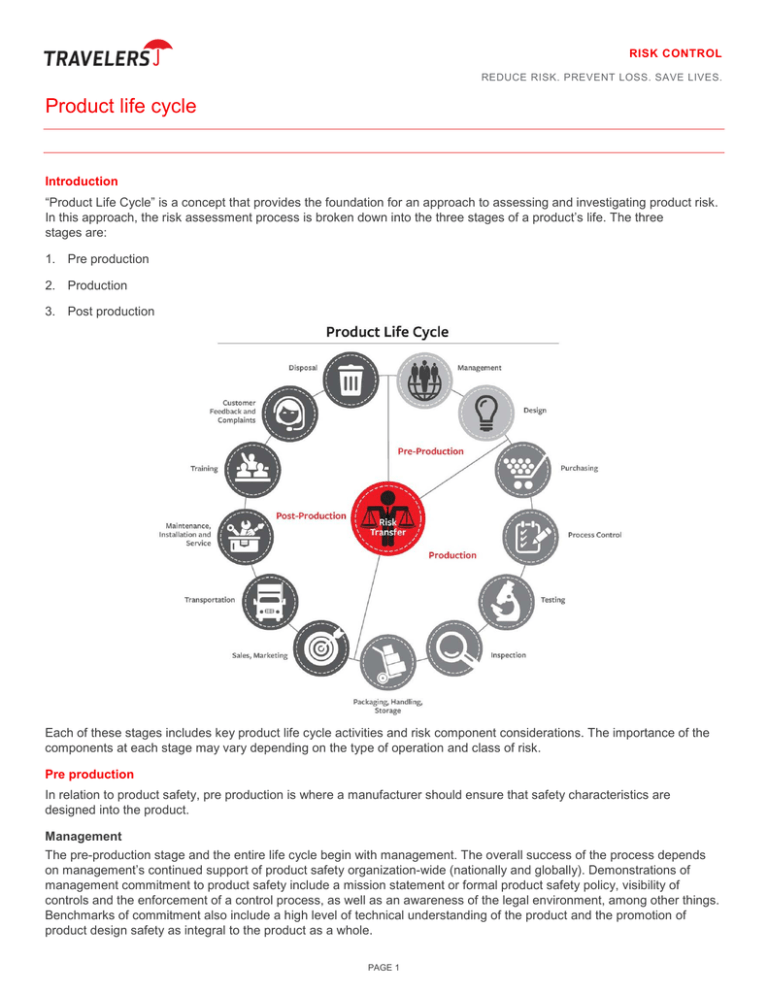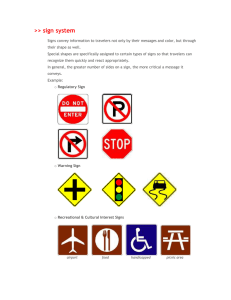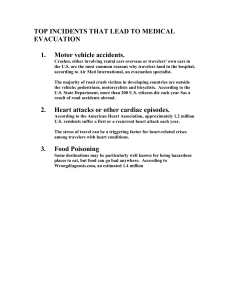
RISK CONTROL
REDUCE RISK. PREVENT LOSS. SAVE LIVES.
Product life cycle
Introduction
“Product Life Cycle” is a concept that provides the foundation for an approach to assessing and investigating product risk.
In this approach, the risk assessment process is broken down into the three stages of a product’s life. The three
stages are:
1. Pre production
2. Production
3. Post production
Each of these stages includes key product life cycle activities and risk component considerations. The importance of the
components at each stage may vary depending on the type of operation and class of risk.
Pre production
In relation to product safety, pre production is where a manufacturer should ensure that safety characteristics are
designed into the product.
Management
The pre-production stage and the entire life cycle begin with management. The overall success of the process depends
on management’s continued support of product safety organization-wide (nationally and globally). Demonstrations of
management commitment to product safety include a mission statement or formal product safety policy, visibility of
controls and the enforcement of a control process, as well as an awareness of the legal environment, among other things.
Benchmarks of commitment also include a high level of technical understanding of the product and the promotion of
product design safety as integral to the product as a whole.
PAGE 1
RISK CONTROL
Product life cycle
Design
“Design” is one of a number of areas where a product may be found to be defective under strict liability or another theory
of liability. Design activity will vary based on the type of business operation and on whether the product is, for instance,
customized, standards driven, a raw material, a component or a sub-assembly. Good design can make all the remaining
steps in the life cycle easier.
There are some basic design activities that all companies should engage in if they are involved with design. These are:
•
Design review
•
Hazard analysis
•
Safety and reliability testing
•
Competitive intelligence
Aside from “competitive intelligence,” which companies should engage in routinely, the degree to which companies are
engaged in any of these other activities will depend on the product. If the product is “mature” and not new to the market,
these activities may decrease or, essentially, cease. If it is a fairly new product or technology, companies should be
engaged in all of these activities as they “fine tune” the product before and during early production.
“Warnings” and “instructions” should be an integral subset (and not an afterthought) of the original design process.
Companies must be diligent in regard to applicable safety and labeling standards, the foreseeable uses and misuses of
their product and the appropriate warnings and instructions that must accompany it. In addition, packaging, handling and
storage, as well as transportability, should be a part of a viable initial design and testing process. They are less likely to be
adequate or effective if they are an afterthought.
In general, design activities, which are thought to indicate above average effort in design work include, but are not limited
to:
•
Sending the product to an outside lab for testing;
•
Conducting extensive safety and reliability testing (crash testing, accelerated life cycle, etc.);
•
Doing competitive analysis of similar products;
•
Getting the customer involved through a focus group and similar testing;
•
Having a product safety review board; and
•
Exceeding standards in some way.
Production
In relation to product safety, production is where a manufacturer should ensure that the safety characteristics designed
into the product actually become part of the product delivered to the customer.
Purchasing
Good purchasing control at the beginning of the manufacturing process can help contribute to cost and safety efficiencies.
A typical precaution is vendor qualification. This can come through previous experience, plant audits and/or completion of
questionnaires. Third-party certifications, like ISO 9000 family of standards, are another way of doing this. The purchaser
uses this information to help ensure the vendor is capable of making materials, components, assemblies or processing
that will meet requirements.
Vendor selection is an important aspect in purchasing. Changing vendors frequently to take advantage of the lowest cost
may seem attractive, but there are advantages in developing longer-term vendor relations. One advantage is the ability to
establish and better manage a Certificate of Insurance (COI) program. A COI program is a “risk transfer technique”
designed to help minimize or deflect loss costs associated with a product liability claim.
PAGE 2
RISK CONTROL
Product life cycle
Process control
“Manufacturing defect,” also known as “bench error,” is another category where a product may be found defective under
strict liability, or another theory of liability. Process control can play an important role in early detection and prevention of
manufacturing defects. The earlier a problem is identified, the easier and less costly it may be to correct. Process controls
contribute to establishing consistency from job to job and include documentation that provides instructions for, among
other things:
•
Tools needed to perform the job;
•
Machinery set-up and operation;
•
Operator qualifications; and
•
Instrumentation and calibration.
Good record keeping and documentation is important in processing as in all phases of the product life cycle. If units and
batches are not traceable, necessary remedial action may become difficult and expensive, with the cost borne by the
manufacturer instead of the supplier or vendor to which the defective part or process might otherwise have been traced.
Good documentation also can make it possible to isolate internal processing problems and correct them quickly.
Testing
Raw material, component, sub-assembly and final product should be tested to verify design requirements are met. Design
requirements can be dictated by a number of things, including:
•
Standard: industry organization developed design and performance specifications.
•
Code: standards that have effectively become laws due to government adoption, like the ASME Boiler and Pressure
Vessel code.
•
Regulation: laws dictating products safety characteristics, like those of CPSC, NHTSA, FDA and USDA.
•
Customer specification: anything the customer decides they want to specify for a product, which sometimes exceeds
regulations, codes or standards.
In the case of some products (components of larger assemblies or custom products), the customer can also dictate what
and how to test. A number of factors influence the decision to test, including:
•
The cost of the testing
•
Uses and users
•
Usage environments
•
Desired life expectancy
•
The likelihood of the hazard
•
The possible consequences of product failure (in terms of frequency and severity)
At a minimum, testing should address critical safety features and components. And, of course, it should be documented.
Inspection
Similar to testing, some form of inspection will be taking place during the production of a product. The two most frequent
are:
•
Visual inspections
•
Dimensional inspections
PAGE 3
RISK CONTROL
Product life cycle
Inspection can be extremely elaborate using coordinate measuring machines or lasers to check dimensions or identify
imperfections. It may be limited to a visual check by a line operator. As with testing, inspections should, at a minimum,
address any safety features appropriately treated by inspection and it should be documented.
Packaging, handling and storage
A product that is otherwise completely safe in design and manufacture may become unsafe because of the way it is
packaged. An example might be the failure of a container of household bleach that results in damage to the user’s floor.
Since claims can arise due to improper packaging, handling or storage of a product, these components and activities
should be a part of a thorough initial design and testing process.
Post production
Post-production activities can positively or negatively impact product safety and potential losses, depending on how well
they are done.
Sales and marketing
Marketing defects can arise when a product that would be reasonably safe, that is, one that is not otherwise defective in
design or manufacture, is placed on the market without adequate warnings or instructions, is packaged improperly, or is
misrepresented in its qualities or capabilities.
Marketing brochures and product-related videos are two areas that could subject a product to product liability issues.
Truthfulness in product representation is important. In instances where there is a claim for bodily injury or property
damage, product misrepresentation may be alleged. Representations about product safety, what the product can do or
what environmental conditions it can withstand should be supported by objective testing and/or experience.
Sales force and manufacturing representatives must take care not to promote a product beyond its capabilities and they
should be qualified to represent the product accurately. They should be trained and knowledgeable in the function and
design of the product.
Transportation
Some form of transportation takes place with all products. The Department of Transportation (DOT) is responsible for
regulating the transport of consumer and industrial goods within the United States. The Hazardous Materials Regulations
Board of the DOT publishes the regulations for the safe handling, shipping and storing of hazardous materials during
transportation. Manufacturers who place their products in packages must know the physical and labeling requirements of
containers.
Transportability should be considered in the design stage. Limitations of the particular mode of transportation should be
considered in determining physical characteristics of items to be shipped, e.g., weight and size. Stacking, palletizing and
other load distribution issues may also be considerations.
Maintenance, installation and service
Personnel from maintenance, installation and service departments come in direct contact with customers. They can be a
vital link in the communications network, both formal and informal, carrying information back and forth between the
company and the user. Maintenance, installation and service activities can contribute to safe product performance.
However, employee mistakes in these activities can create an additional exposure. A company must closely monitor the
professional skills and performance of these employees to help ensure they follow established company procedures.
Whether employees or independent contractors, personnel involved with these three field operations are in an especially
good position to notice safety and performance items that may have escaped previous detection, such as:
•
Defects in parts and components
•
Improper installation
•
Improper use
•
Improper maintenance
PAGE 4
RISK CONTROL
Product life cycle
•
Improper repair
•
Modifications
•
Length of service irregularities
These observations should be described in a written report and properly communicated within the company to facilitate
appropriate corrective action. If a product enhancement can be made to help improve safety, the company can consider a
number of actions, including:
•
A service or technical bulletin;
•
A recall, retrofit or field modification; or
•
Modifications or enhancements in future designs.
Training customers, dealers and distributors
As with other life cycle components, a product that is otherwise safe in design and manufacture may become unsafe
because of the way it is used. This can be because the user was not properly instructed or the user was unable to
understand the instructions. Conversely, good presentation of instructions can increase the likelihood that a product will
be used safely and effectively. This raises the importance of training. At a minimum, any training should include
information on product capabilities, limitations and safe vs. unsafe uses. This should be true whether training is intended
for end users or people involved in sales, service or distribution.
Customer feedback and complaints
An effective system of handling customer feedback and complaints serves two main purposes in relation to product
safety. 1) It can head off a potential loss by remedying the customers’ complaints or concerns; and 2) it can gather
important information on how the product performs and how it is used in the real world. This information can be fed back
into the other life cycle stages like design and process control to improve the next generation of products. Feedback also
can be an early warning system alerting the manufacturer to situations where a recall or other post-sale action may be
needed to prevent accidents and claims.
In small organizations, an informal system may be effective. For larger organizations or where customer feedback is
frequent, a more organized system may be needed to maintain a consistent message to customers and to help ensure
that all feedback is gathered and evaluated so that trends do not go undetected. Both external and internal feedback
needs to be considered. Formal analysis of feedback (Paretto analysis, etc.) may be appropriate where volume is
significant.
Disposal
There are two main disposal issues that can raise safety concerns:
•
The product has ended its useful life and is being scrapped or permanently disposed of.
•
The product is in its second, third, fourth, etc., existence. (This is also called the “secondary market” or when the
product is resold to another.)
For scrapped products, the concern can be for environmental reasons or the safety of someone trying to use it. Examples
include NiCad batteries and refrigerators, respectively.
For products with a secondary market, the issues are numerous and include:
•
Advances in technology may have effectively rendered the older product unsafe
•
Unsafe re-manufacturing
•
Difficulty effectively upgrading to existing standards and codes
•
Lack of manuals, operating instructions, original or current labeling
PAGE 5
RISK CONTROL
Product life cycle
•
Modifications to perform operations other than intended
•
Removal of safety features
•
Lack of compatibility with other products
•
Multiple sales complicate recall activity
Companies should be aware of the life expectancy of their product and the propensity of the product to have an extended
life with multiple owners. They also should be aware of their disposal risks.
Risk transfer
All business depends on other businesses to produce a finished product, including product manufacturers. Without proper
planning and review of exposures these relationships create, a company may encounter unexpected claim costs. The
intent of a risk transfer review program is to help ensure that your company is not financially vulnerable to damages and
claims due to acts, errors or omissions caused or contributed to by others. A program should be designed to uncover,
remove and/or minimize exposure. The goal is to keep liability with the party best equipped to control the exposure and
make sure that these third parties are financially able to pay.
Key risk transfer tools include:
•
Certificates of Insurance confirm what coverage is in force at the time issued and expiration date.
•
Hold harmless agreements establish that one party hold another party harmless under described circumstances.
These agreements can be special contracts or standard contracts like a work or purchase order. Legal counsel should
review such documents.
•
Vendors coverage endorses a manufacturer’s policy and says that the manufacturer’s insurance company extends its’
products liability coverage to those who sell the manufacturer’s product without change, in the event they are named
in a product liability claim.
For more information, log in to the Risk Control Customer Portal at travelers.com/riskcontrol. (Need help? Read
our Registration Quick Guide.) You also can contact your Risk Control consultant or email Ask-RiskControl@travelers.com.
travelers.com
The Travelers Indemnity Company and its property casualty affiliates. One Tower Square, Hartford, CT 06183
The information provided in this document is intended for use as a guideline and is not intended as, nor does it constitute, legal or professional advice. Travelers does not
warrant that adherence to, or compliance with, any recommendations, best practices, checklists, or guidelines will result in a particular outcome. In no event will Travelers or
any of its subsidiaries or affiliates be liable in tort or in contract to anyone who has access to or uses this information. Travelers does not warrant that the information in this
document constitutes a complete and finite list of each and every item or procedure related to the topics or issues referenced herein. Furthermore, federal, state or local
laws, regulations, standards or codes may change from time to time and the reader should always refer to the most current requirements. This material does not amend, or
otherwise affect, the provisions or coverages of any insurance policy or bond issued by Travelers, nor is it a representation that coverage does or does not exist for any
particular claim or loss under any such policy or bond. Coverage depends on the facts and circumstances involved in the claim or loss, all applicable policy or bond
provisions, and any applicable law.
© 2008-2014 The Travelers Indemnity Company. All rights reserved. Travelers and the Travelers Umbrella logo are registered trademarks of The Travelers Indemnity
Company in the U.S. and other countries. 843
PAGE 6


